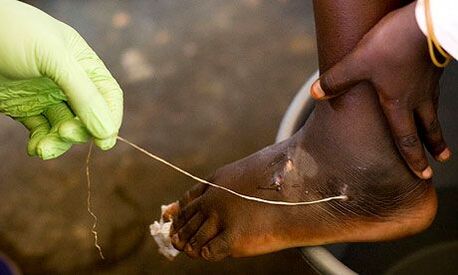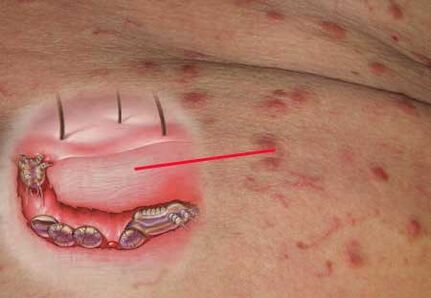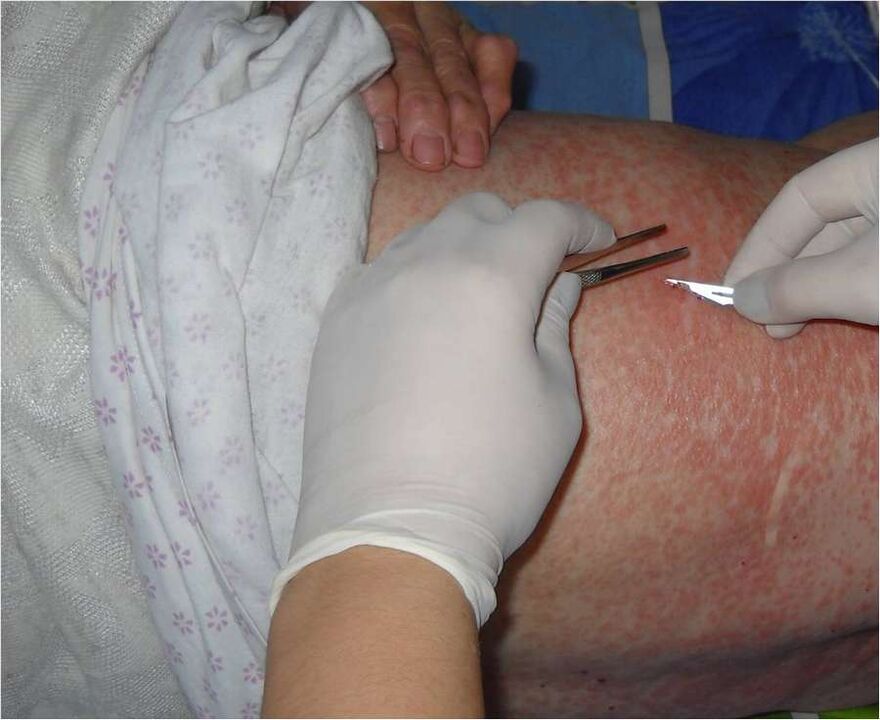Helminths are subcutaneous parasites that live in the human body. They feed on the host's cells, releasing toxic substances. Infection with parasites can lead to serious illness, at worst, death. Depending on the type of worms, the displacement locations are different. Some reproduce in organs, some live under human skin, causing the development of dermatoses.
Varieties of Subcutaneous Parasites and Methods of Infection
Parasitic skin diseases are not common types of pathologies. Despite this, cases of illnesses have been reported. They are more likely to visit Asian regions and countries with warm climates. Parasites in the human body cause an allergic reaction, accompanied by an unbearable itching.
In medicine, worms are divided into two types:
- Subcutaneous. Helminths are difficult to diagnose. After the infection and the maturation stage, the parasites move through the human body. The most common types of subcutaneous helminths are: iron, scabies mites, filariae, rishta.
- Dermal. After contact with human skin, the parasites migrate to different parts of the body. As a result of infection by skin parasites, inflammation of the pancreas, development of squamous lichen, eczematosis and diabetes mellitus occur.
Common cases include infection with a tick located in the sebaceous glands. It is distinguished by an outlet to the surface of the epidermis during the day to feed secretions from the cutaneous ducts.
Filariasis
Filariasis is the defeat of a person by nematode-like parasites. It is found in countries in the Asian region as well as in tropical climate locations. The most likely form of infection is visiting tourist areas. The main danger of parasites is the long incubation period. Without symptoms, the worms can live under the skin for 5 to 7 years. Plagues are distinguished by excessive vital activity, which causes symptoms of intoxication in the patient.

In the early stages, the disease shows signs of urticaria. As the worms grow and multiply, there is loss of vision, formation of movable seals, and fever. In later stages, the location of the worms is determined with the naked eye.
Dracunculiasis
Dracunculiasis is a disease caused by subcutaneous helminth infection. They are able to live in open water. Human infestation occurs during the trip, when drinking raw water from unverified sources. In an infected person, the larvae are located under the upper layer of the epidermis. The presence of even a parasite without proper treatment leads to death. In worldwide practice, adult helminths with a length of 100 centimeters have been registered. They can take up all the space in the stomach, liver or block the airways. Helminths are most often located in a person's lower extremities.
Helminths are most often located in a person's lower extremities.
The main symptoms of an injury include:
- rashes on the legs;
- the formation of fluid-filled bubbles;
- intolerable itching;
- the appearance of bumps;
- purulent formations.
The main treatment is surgical removal of helminths from the body.
schistosomiasis
The disease causes several types of helminths found in water bodies. The infection occurs when swimming in rivers and lakes in the African and Asian region. Another form of infection is untested drinking water. It is the source of dissemination of parasite eggs and larvae. Initially, helminths are located under the epidermis. An allergic rash forms on the skin, accompanied by itching. As the disease develops, the larvae penetrate deep into the body. The patient's kidneys and liver are severely affected. The disease is accompanied by nocturnal fevers, profuse sweating. An enlarged liver and deformed kidneys can help diagnose the infection.

Cysticercosis
Cysticercosis is a disease associated with human infection by porcine tapeworm. The parasite belongs to the tongs category, lives in Asian countries. For the development of an adult in the human body, the penetration of 1 larva or part of a worm is enough. Parasites are highly regenerative, which complicates the treatment process.
The main signs of injury include hives, itching, general weakness, pain. Worms are often located under the skin, in muscles, eyes, internal organs and in the brain. During adult development, a tubercle or induration forms under the skin. Over time, it can increase, it brings inconvenience. The main breeding sites for porcine tapeworms are the shoulders, chest, arms and palms.
Dirofilaria
The main method of worm infestation is the penetration of larvae through insect bites or contact with animals. The temporary carriers of larvae are dogs and cats, mosquitoes act as carriers. The female worm is 30 centimeters long and the male 10 centimeters. Parasite development occurs under the upper layer of the epidermis.
Parasite development occurs under the upper layer of the epidermis.
Eggs remain on human skin with a mosquito bite. The hatched larva penetrates deep into the skin through the injured area of the skin. There she goes through all the stages of her growth. The illness is accompanied by an unbearable itching. Seals are observed in the worm location areas. The patient feels the adults move under the skin. Vision loss is possible if affected by helminths.
The treatment of worms is carried out by an operative method. After the operation, patients are given drugs that restore the affected skin and organs.
Scabies
Scabies is an infection of a person with the scabies mite. The disease is named after an intense and unbearable itching throughout the body. In places where ticks are located, people develop redness and blemishes.
A tick infestation occurs through bodily contact with an infected person or their personal belongings. Diagnosis is made by visual examination of the skin and laboratory tests. At home, the diagnosis can be made with iodine. When it comes in contact with the affected skin, a spider's web becomes noticeable - the path of movement of ticks under the skin of an infected person.
At home, the diagnosis can be made with iodine. When it comes in contact with the affected skin, a spider's web becomes noticeable - the path of movement of ticks under the skin of an infected person.
The main symptoms of scabies include:
- itchiness and redness of the skin;
- the formation of fluid-filled blisters when scratching the skin;
- location of injuries to the hands and joints.
The treatment of the disease is long and laborious. It is almost impossible to completely eliminate the parasites.
demodecosis
Demodectic mange is a human infection caused by subcutaneous ticks. They are located in the sebaceous glands of the infected. In the early stages, the disease can easily be mistaken for acne. As the mites multiply, the rash increases and spreads all over the face. Eyelash loss begins.
The diagnosis of demodicosis is simple. For this, a visual examination and a series of laboratory tests are performed. The treatment of the disease is long-term. In some cases, it takes several years. Tick infection occurs through direct contact with the patient, use of personal belongings or cosmetic products of the infected person. Successful tick reproduction is facilitated by an unstable hormonal background and a weakened immune system.
disease symptoms

Modern medicine distinguishes several types of subcutaneous parasites. They cause the development of skin dermatitis and internal organ disturbances. Depending on the pathogen in a person, symptoms appear in a peculiar way. Despite this, there are several signs, when they appear, it is recommended to consult a specialist.
You can learn about worms in the body by a series of signs:
- general weakness;
- increase in temperature to 39°C;
- itchy skin in varying degrees of intensity;
- the appearance of skin rashes;
- gastrointestinal tract disorder;
- the formation of seals on the skin.
It is important to note that an early medical appointment allows you to get rid of the parasites that live under the human skin quickly.
Diagnostic Features
Subcutaneous parasites in humans are difficult to diagnose. Therefore, at the first suspicion of an injury, it is necessary to consult a specialist. The complexity of diagnosis is directly related to the latent course of the disease. Basically, vivid symptoms appear only a few years after defeat, which negatively affects health.

Several symptoms indicate helminthic invasion, but there is no general clinical presentation. It is necessary to rule out defeat of the patient with helminths in case of redness of the skin areas, appearance of constant itching, and various spots on the skin.
A visit to several specialists allows you to make the correct diagnosis:
- dermatologist;
- neuropathologist;
- allergist;
- specialist in infectious diseases;
- psychologist.
Consultation with a psychologist occurs if no deviations are found in the direction of other specialists.
To clarify the diagnosis, patients undergo laboratory tests:
- blood test for antigens;
- examination of a skin sample;
- smear;
- secret research;
- scraping the affected area.

The results of laboratory tests can detect parasites under the skin. If in the last six months before the onset of symptoms there were trips to Asian countries or other tropical regions, this fact should be indicated to the doctor.
The diagnosis of subcutaneous parasites requires the appointment of a competent therapeutic regimen. In this situation, the use of drugs or traditional medicine methods not recommended by the attending physician is prohibited. Violation of the therapy regimen can lead to deterioration and poisoning of the body.
effective treatments
In medical practice, there are two methods of therapy for parasites: medical and surgical. Depending on the complexity of the injury, the doctor uses one method or both in combination. The choice of therapeutic treatment methods depends on the risk to the patient's health and the characteristics of the parasites.

The choice of therapy method is influenced by:
- the number of parasites in the patient's body;
- worm regenerative capacity;
- reproduction rate;
- parasite location;
- the patient's allergic reactions;
- the severity of the disease;
- possible or existing complications.
Drug treatment involves taking a course of drugs. The action of drugs involves exposure in several directions:
- Destruction of adult worms and larvae in the body, preventing their reproduction. For this, anthelmintic drugs are used.
- Removal of inflammation and destruction of infection foci. For this, a course of antibiotic therapy is carried out.
- Acceleration of the elimination of toxins and elimination of an allergic reaction. The patient is given a course of antihistamines and glucocorticoids.
- Healing of the affected areas of the skin. To accelerate the regenerative function of the epidermis, creams and ointments are used.
Surgical treatment of subcutaneous parasites is recommended in cases where there are severe complications and a special location of the worm is present. The operation has shown high efficiency in cases where the body is known to be affected by only one individual. Most of the time, surgical intervention is used for dracunculiasis. The worm's internal fluid contains toxic substances that can cause anaphylactic shock. In this case, a holistic extraction of the parasite is shown.
prevention methods
Skin parasite infection in humans requires prolonged therapy. The problem can be avoided by following a series of preventive measures:
- Compliance with hygiene rules. Hands should be washed under running water with soap or an antiseptic. Especially after contact with unknown or stray animals. Scratches, cuts and other damage to the skin should be treated with an antiseptic.
- Product processing. Fresh vegetables and fruits should be rinsed well under running water before use. It is recommended to heat fish, poultry and meat. Avoid eating raw or semi-raw meat.
- Use of proven water sources. Water from unknown sources must be treated. Open water bodies and springs deserve special attention.
- Routine vaccination. Before traveling to tropical countries, it is necessary to be vaccinated against the main diseases.
- General makeup use. Women should avoid sharing makeup, even with close friends.
- Swimming in open water. Swimming in polluted or untested water bodies is prohibited. During the warm season, water bodies that have been tested for water quality should be preferred.
A responsible attitude towards one's health and adherence to preventive measures help to prevent parasitic dermatitis.
























